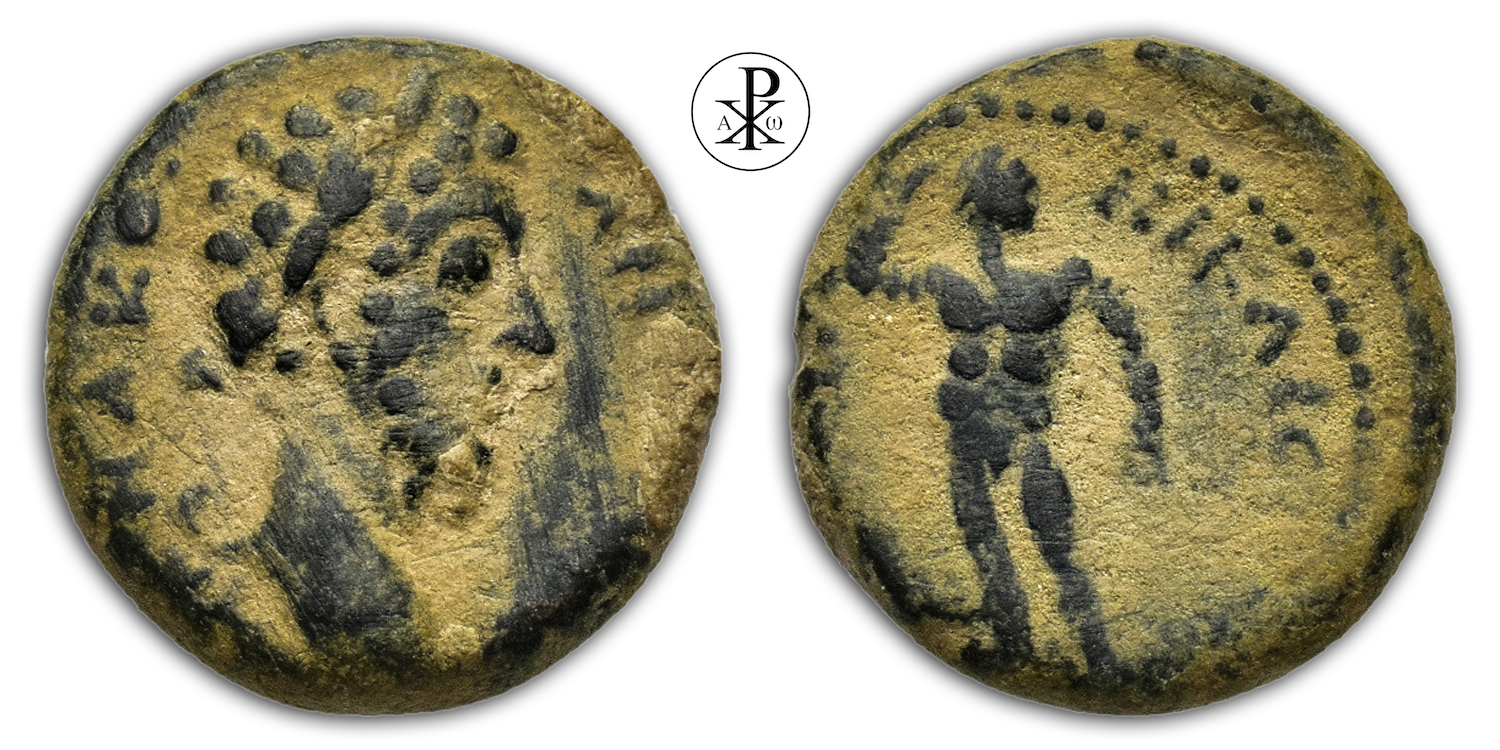Imperator Caesar Marcus Aurelius Commodus Antoninus Augustus
Reign: Commodus
Mint: Nicaea, Bithynia
Date: 180/191 AD
Nominal: Bronze
Material: AE
Diameter: 15mm
Weight: 3.62g
Reference: RPC IV.1 25063 (this coin)
RPC Online: https://rpc.ashmus.ox.ac.uk/coins/4/25063
Rare: Specimens 1 (0 in the core collections)
Provenance: N&N Numismatics London, Great Britain (Auction 14, Lot 150)
Pedigree: –
Special: RPC Online Plate coin
Obverse: Bare head of Commodus, right
Inscription: Α Κ Μ ΑV ΚΟ ΑΝΤΩ
Translation: Autokrator Kaisaros Marcos Aurelios Kommodos Antoninos
Translation: Imperator Caesar Marcus Aurelius Commodus Antoninus
Reverse: Nude Athlete standing, facing, head, right, placing crown on his head
Inscription: ΙƐΡΟϹ ΑΓΩΝ ΝΙΚΑΙƐΩΝ
Translation: Ieros Agon Nikaieon
Translation: Sacred athletic competition, City and People of Nicaea
Comment: Nicaea, also known as Nicæa, Nicea or Nikaia, was an ancient Greek city in the north-western Anatolian region of Bithynia. The ancient city is located within the modern Turkish city of İznik (whose modern name derives from Nicaea’s). The place is said to have been colonized by Bottiaeans, and to have originally borne the name of Ancore or Helicore, or by soldiers of Alexander the Great’s army who hailed from Nicaea in Locris, near Thermopylae. Along with the rest of Bithynia, Nicaea came under the rule of the Roman Republic in 72 BC. The city remained one of the most important urban centres of Asia Minor throughout the Roman period, and continued its old competition with Nicomedia over pre-eminence and the location of the seat of the Roman governor of Bithynia et Pontus. Emperor Hadrian visited the city in 123 AD after it had been severely damaged by an earthquake and began to rebuild it. The new city was enclosed by a polygonal wall of some 5 kilometres in length. The numerous coins of Nicaea which still exist attest the interest taken in the city by the Roman emperors, as well as its attachment to the rulers; many of them commemorate great festivals celebrated there in honor of gods and emperors, as Olympia, Isthmia, Dionysia, Pythia, Commodia, Severia, Philadelphia, etc.
When Augustus reorganised the eastern provinces of the empire in 30 BC after his victory over Antony, he had temples built in the cities of Nicomedeia and Nicaea, which were central places of worship for the entire province. The temple in Nicaea was dedicated to the goddess Roma and the Divus lulius, i.e. the dictator Caesar, the deified adoptive father of Augustus. This cult was later transformed into a general cult of the emperors. The personified city of Nicaea itself was considered the administrator of the cult. She had the right to the honorary title of “Steward of the Cult of Augusti”. In Hadrian’s time, the East Gate was renewed and the honorary titles of the city of Nicaea were engraved on it – among others, the city was allowed to call itself “Pious Steward of the Cult of the Emperor”. The city received the right to hold festive assemblies of all Bithynia. The council also met on this occasion. In connection with the annual assemblies of the κοινόν (Council meeting), a fair was held, but so were festive games (agon), both musical and gymnastic (CIG 1720. 3428). The so-called “Koina Bithynias” took place in the city under the name of “the Augousteia of Nicaea”.
In ancient Greece, an agon was a sporting or musical competition. The most famous agons were the Olympic, Pythian, Nemean and Isthmian Games, which are collectively known as the Panhellenic Games. In addition, there were other competitions, some of which lasted only a short period of time, such as the Ptolemaia or the Antinoeia. From Augustus onwards, the Greek agons were frequently imitated in Rome and other cities of the Roman Empire. Nero founded the Neronia, which recurred every five years, on the model of the Olympic Games. The so-called Isthmian Games were competitions in ancient Greece, named after the Isthmos of Corinth, where they were celebrated in honour of Poseidon from 580 BC. A sacred pine grove encompassed the sanctuary of the Isthmian Poseidon and the battlefields: the Hippodrome for the horse race, a stadium for the footrace, an important theatre for the musical competitions and the Kraneion, a respectable gymnasium. Their foundation is attributed partly to Poseidon, partly to Theseus, and they survived with varying validity until the Roman imperial period. Sisyphus is also mentioned as the founder: He is said to have donated the games to his nephew Melicertes, whose body he found on the coast of Corinth and buried after Melicertes had been killed by his mother Ino in a fit of madness and thrown into the sea. Apart from these “big” isthmuses, there were also “smaller” ones, for example in the city of Nicaea. Although the agones in the other provinces of Asia Minor (such as in Bithynia) did not rank among the most prestigious contest of the festival network, they were part of vibrant secondary agonistic circuits that managed to atrract quiet a lot of competitors, especially those for whom a competition in the major agonistic centres was too strong.
The connection to the so-called “Commodeia” games of Emperor Commodus is not certain. Emperor Commodus liked to be portrayed as the new Heracles and, among other things, allowed the city of Nicaea, whose mythical founder was Heracles, to organise festivals under his name (as he also did in other cities). The unanswered questions concerning the issue of this coin are: does the depiction deal with the annual festivals and games that had already taken place before Commodus, which were now renamed “Commodeia” for the emperor – or does this coinage explicitly refer to separate games in honour of the emperor Commodus? Why, then, does the legend on the reverse only refer to the “sacred games” and not directly to the so-called “Commodeia” games?
